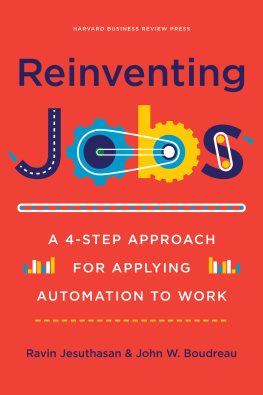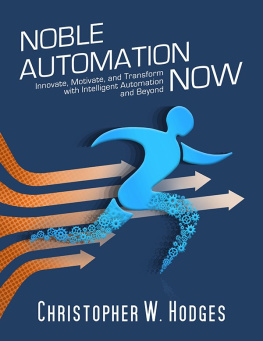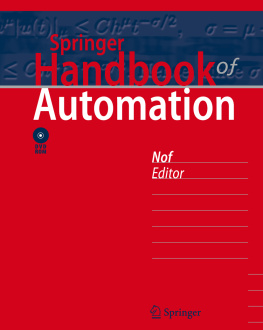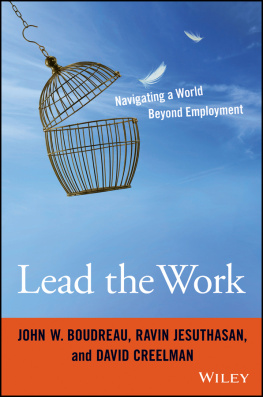Amid all the apocalyptic visions about tomorrows workplacefrom widespread unemployment to pitched battles between man and machinecomes a bracing dose of common sense. Reinventing Jobs cuts through the hype and hysteria and shows leaders how to apply automation and artificial intelligence in their organizations. Jesuthasan and Boudreau are the clear-eyed guides every organization needs to track their way through the future of work.
DANIEL H. PINK, author, Drive and When
In the age of the internet of things (IoT) and AI, the traditional notions of Economic Man and Social Man need to be superseded by the concept of Self-motivated Man. Reinventing Jobs is a book ahead of its time and points the way to the humanization of the enterprise.
ZHANG RUIMIN, Chairman and CEO, Haier Group
Reinventing Jobs provides a step-by-step guide to rethinking how organizations deal with automation. Jesuthasan and Boudreau provide leaders with a thoughtful framework that helps us ask the right questions when were considering where and when to automate. They recognize that automation is not a simple rip and replace of certain jobs and tasks, but rather something that requires a layered approach.
JIM WHITEHURST, President and CEO, Red Hat
This book provides an excellent, much-needed framework to guide the collaboration necessary among CIOs, CHROs, and other functional leaders to optimize work and the application of automation in todays rapidly changing environment.
RALPH W. BROWN, Chief Technology Officer and Senior Vice President, Research & Development, CableLabs
A must-read for every CEO. A most thoughtful approach with examples from numerous industries that illustrate that automation and workflow optimization are critical to competing effectively.
ANTHONY G. PETRELLO, Chairman, President, and CEO, Nabors Industries
Reinventing Jobs is a book that CIOs, CHROs, and all C-suite leaders should read together. This four-step framework takes the guesswork out of building your digital strategy and a future-ready, engaged, and agile workforce.
DIANA MCKENZIE, Senior Vice President and CIO, Workday
This book provides a thoughtful, step-by-step guide to responsible automation that is relevant to all leaders in government, academia, and the private sector. Jesuthasan and Boudreau bring an insightful and practical approach to dealing with one of the most significant challenges of the Fourth Industrial Revolution.
SAADIA ZAHIDI, Head of Education, Gender and Work and member of the Executive Committee, World Economic Forum
We live in a world where advanced technologies are disrupting entire industries, yet few have advanced the discussion beyond a surface consideration of technology either eliminating or creating jobs. Now, Jesuthasan and Boudreau offer a comprehensive approach to transforming work while enabling organizationsand individualsto adapt and thrive.
ALAN MAY, Chief People Officer, Hewlett Packard Enterprise
Copyright
HBR Press Quantity Sales Discounts
Harvard Business Review Press titles are available at significant quantity discounts when purchased in bulk for client gifts, sales promotions, and premiums. Special editions, including books with corporate logos, customized covers, and letters from the company or CEO printed in the front matter, as well as excerpts of existing books, can also be created in large quantities for special needs.
For details and discount information for both print and ebook formats, contact .
Copyright 2018 Harvard Business School Publishing Corporation
All rights reserved
No part of this publication may be reproduced, stored in or introduced into a retrieval system, or transmitted, in any form, or by any means (electronic, mechanical, photocopying, recording, or otherwise), without the prior permission of the publisher. Requests for permission should be directed to , or mailed to Permissions, Harvard Business School Publishing, 60 Harvard Way, Boston, Massachusetts 02163.
First eBook Edition: Oct 2018
ISBN: 978-1-63369-407-1
eISBN: 978-1-63369-408-8
To my family, friends, colleagues, and church for your inspiration, love, and support.
Ravin Jesuthasan
To my family and the students and colleagues who honor me every day by sharing their wisdom and support. It is a gift to share our collective journey of reinvention.
John Boudreau
Once the bedrock of competitive advantage, legacy, whether mindset or infrastructure, is increasingly the primary obstacle to sustainable automation and the future of work.
CONTENTS
ACKNOWLEDGMENTS
We are grateful for the support and encouragement of our colleagues at Willis Towers Watson. We particularly appreciate the assistance provided by Anne-Marie Jentsch, George Zarkadakis, Juliet Taylor, Tracey Malcolm, Kannie Kong, Maggy Fang, and Edward Liu in the writing of this book. Thanks as well to David Creelman for his help, encouragement, and insights.
Thanks to the team at Harvard Business Review Press, particularly our wonderful, tireless, supportive, and insightful editor Melinda Merino, who saw the potential of this book far earlier and more clearly than anyone.
INTRODUCTION
AI and Robotics Are Here. Now What?
If you are a leader wrestling with where, when, and how to apply automation in your organization, youre in good company. Leaders everywhere are asking how automation will affect their organizations and how jobsthose of their teams, bosses, colleagues, friends, and families as well as their ownmight change or even be eliminated. Optimists say that machines will free human workers to do higher-value, more creative work. Pessimists predict massive unemployment or even an apocalypse in which humans merely serve the robots. Of course, both the optimists and the pessimists are partially correct and partially wrong.
But what everyone gets wrong is asking, In which jobs will automation replace humans? We see smart and well-meaning leaders get stuck in the typical discourse about job replacement. Its a dead-end conversation. Simply asking which humans will be replaced fails to take into account how work and automation will evolve. You cant solve the how to automate work problem by thinking only about automation replacing jobs.
Consider the example of the automated teller machine (ATM). A familiar example, for sure, but one that illustrates the myopia that comes from asking, Which jobs will be replaced by automation? Its also a good example to start with because the evolution of banking work, through automation, is continuous.
Did the ATM Mean the End of Bank Tellers?
On June 14, 2011, Barack Obama noted that ATMs allowed businesses to become much more efficient with a lot fewer workers. Understanding how automation affects work clearly requires a more nuanced approach than how many jobs do ATMs replace?
Economist James Bessen explains the paradox of more ATMs creating more teller jobs in his book Learning by Doing .
Why is there such stability in the number of bank employees as automation advances? The work of the teller job has evolved. Where the bank branches still stand as a brick-and-mortar presence, the tellers have started coming out from behind the window with smartphone or tablet in hand to help customers help themselves. But with thousands of those branches closing, youre more likely to find a teller online now. Theyve become the human face of an increasingly virtual world. Its a role exemplified in Bank of Americas new experiment with hybrid banking, small unstaffed mini-branches that offer a direct link to tellers via video conference.








